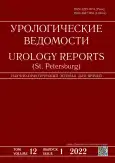Cryoablation of localized renal cancer on the MKS cryotherapy unit with liquid nitrogen as a cryogen: functional and oncological efficiency of the method
- Authors: Shchekuteev N.A.1, Nosov A.K.1, Prohorov G.G.1, Burovik I.A.1
-
Affiliations:
- N.N. Petrov National Medical Research Center of Oncology
- Issue: Vol 12, No 1 (2022)
- Pages: 55-62
- Section: Original articles
- URL: https://journals.rcsi.science/uroved/article/view/96357
- DOI: https://doi.org/10.17816/uroved96357
- ID: 96357
Cite item
Abstract
BACKGROUND: Ablation is a method of destroying a pathological focus using a controlled temperature or other effect. The most promising ablative treatment for localized kidney cancer today is cryoablation.
AIM: To analyze functional and oncological results of cryoablation of localized kidney cancer using liquid nitrogen as cryogen.
MATERIALS AND METHODS: Between 2017 and 2020, 56 patients with suspected localized kidney cancer were observed and treated at the N.N. Petrov National Medical Research Center of Oncology. With morphological verification, renal cell carcinoma was detected in 19 (65.5%) patients, chromophobe renal cell carcinoma – in 3 (10.4%), oncocytoma – in 3 (10.4%), in 4 (13.8%) cases the tumor was not detected in morphological material. All patients underwent cryoablation using the MKS cryotherapy unit with liquid nitrogen as a cryogen (ultrasound-guide cryotherapy was performed in 4 (7.1%) cases, CT-guide – in 46 (82.1%), laparoscopically – in 6 (10.7%) patients).
RESULTS: Renal function in this study was assessed by creatinine level and glomerular filtration rate (GFR) before and after cryoablation. The creatinine level before cryoablation was 101 ± 18 µmol/l, after – 113.8 ± 18 µmol/l (p = 0.21), GFR before cryoablation – 63 ± 13 ml/min, after – 65 ± 13 ml/min. These differences were not significant (p = 0.87). Local disease control was achieved in 100% of cases. The overall and specific survival rate were 100% (one patient died from synchronous primary multiple cancer at 4 years of observation), the survival rate to recurrence was 90.9 ± 3.9%, and the event-free survival was 70.2 ± 6.6%. During the follow-up period, 9 (16%) recurrences of the disease were diagnosed.
CONCLUSIONS: Cryoablation makes it possible to maintain a large volume of renal parenchyma, thereby not reducing the functional ability of the kidney. In addition, the outcomes and survival rates are quite high, making it an alternative option for other nephron-saving operations.
Keywords
Full Text
##article.viewOnOriginalSite##About the authors
Nikita A. Shchekuteev
N.N. Petrov National Medical Research Center of Oncology
Email: dr.shchekuteev@gmail.com
ORCID iD: 0000-0001-9625-3907
SPIN-code: 5837-8625
Oncologist
Russian Federation, 68, Leningradskaya st., Pesochnyj village, St. Petersburg, 197758Alexander K. Nosov
N.N. Petrov National Medical Research Center of Oncology
Email: nakuro@yandex.ru
ORCID iD: 0000-0003-3850-7109
SPIN-code: 1711-1476
Cand. Sci. (Med.), Head of the Surgical Oncourogical Department, Senior Researcher
Russian Federation, 68, Leningradskaya st., Pesochnyj village, St. Petersburg, 197758Georgiy G. Prohorov
N.N. Petrov National Medical Research Center of Oncology
Email: gprokhorov@mail.ru
ORCID iD: 0000-0001-9015-3817
SPIN-code: 9166-4705
Dr. Sci. (Med.), Professor, Leading Researcher
Russian Federation, 68, Leningradskaya st., Pesochnyj village, St. Petersburg, 197758Ilia A. Burovik
N.N. Petrov National Medical Research Center of Oncology
Author for correspondence.
Email: burovick_ilya@mail.ru
ORCID iD: 0000-0002-4714-1228
SPIN-code: 1923-6457
MD, Cand. Sci. (Med.), Radiologist
Russian Federation, 68, Leningradskaya st., Pesochnyj village, St. Petersburg, 197758References
- Cooper IS. Cryobiology as viewed by the surgeon. Cryobiology.1964;1(1):44–54. doi: 10.1016/0011-2240(64)90019-7
- Gill W, Fraser J, Carter DC. Repeated freeze-thaw cycles in cryosurgery. Nature. 1968;219:410–413. doi: 10.1038/219410a0
- Gage AA, Augustynowicz S, Montes M, et al. Tissue impendence and temperature measurements in relation to necrosis in experimental cryosurgery. Cryobiology. 1985;22(3):282–288. doi: 10.1016/0011-2240(85)90148-8
- Hewitt PM, Zhao J, Akhter J, Morris DL. A comparative laboratory study of liquid nitrogen and argon gas cryosurgery systems. Cryobiology. 1997;35(4):303–308. doi: 10.1006/cryo.1997.2039
- Georgiades CS, Rodriguez R. Efficacy and safety of percutaneous cryoablation for stage 1A/B renal cell carcinoma: results of a prospective, single-arm, 5-year study. Cardiovasc Interv Radiol. 2014;37:1494–1499. doi: 10.1007/s00270-013-0831-8
- Gunn AJ, Joe WB, Salei A, et al. Percutaneous cryoablation of stage T1b renal cell carcinoma: safety, technical results, and clinical outcomes. Cardiovasc Interv Radiol. 2019;42:970–978. doi: 10.1007/s00270-019-02226-5
- Kaprin AD, Starinskii VV, Shakhzadova AO. Zlokachestvennye novoobrazovaniya v Rossii v 2020 godu (zabolevaemost’ i smertnost’). Moscow: MNIOI im. P.A. Gertsena – filial FGBU “NMITs radiologii” Minzdrava Rossii, 2021. (In Russ.)
- Auer T, Heidegger I, de Zordo T, et al. Fusion Imaging of Contrast-enhanced Ultrasound With CT or MRI for Kidney Lesions. In Vivo. 2019;33(1):203–208. doi: 10.21873/invivo.11460
- Abushamma F, Barqawi A, Al-Jabi SW, et al. Global Analysis of Research Trends on Kidney Function After Nephron-Sparing Surgery: A Bibliometric and Visualised Study. Cancer Manag Res. 2021;13:7479–7487. doi: 10.2147/CMAR.S324284
- Breen DJ, King AJ, Patel N, et al. Image guided cryoablation for sporadic renal cell carcinoma: three- and 5 year outcomes in 220 patients with biopsy-proven renal cell carcinoma. Radiology. 2018;289(2):554–561. doi: 10.1148/radiol.2018180249
- Gervais DA. Cryoablation versus radiofrequency ablation for renal tumor ablation: time to reassess? J Vasc Interv Radiol. 2013;24(8):1135–1138. doi: 10.1016/j.jvir.2013.05.030
- Zhou W, Herwald SE, McCarthy C, et al. Radiofrequency ablation, cryoablation, and microwave ablation for t1a renal cell carcinoma: a comparative evaluation of therapeutic and renal function outcomes. J Vasc Interv Radiol. 2019;30(7):1035–1042. doi: 10.1016/j.jvir.2018.12.013
- Zhou W, Arellano RS. Thermal ablation of T1c renal cell carcinoma: a comparative assessment of technical performance, procedural outcome, and safety of microwave ablation, radiofrequency ablation, and cryoablation. J Vasc Interv Radiol. 2018;29(7):943–951. doi: 10.1016/j.jvir.2017.12.020
- Gunn AJ, Parikh NS, Bhatia S. Society of Interventional Radiology quality improvement standards on percutaneous ablation in renal cell carcinoma. J Vasc Interv Radiol. 2020;31(2):195–201.e3. doi: 10.1016/j.jvir.2019.11.004
- Katsanos K, Mailli L, Krokidis M, et al. Systematic review and meta-analysis of thermal ablation versus surgical nephrectomy for small renal tumors. Cardiovasc Interv Radiol. 2014;37:427–437. doi: 10.1007/s00270-014-0846-9
- El Dib R, Touma NJ, Kapoor A. Cryoablation vs radiofrequency ablation for the treatment of renal cell carcinoma: a meta-analysis of case series studies. BJU Int. 2012;110(4):510–516. doi: 10.1111/j.1464-410X.2011.10885.x
Supplementary files








